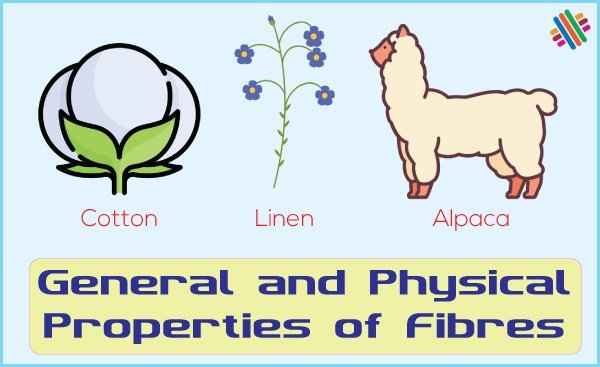Physical and Chemical Properties of Cotton
Last updated on October 11th, 2023 at 11:44 pm
The cotton fibre comes from the fruit of the cotton plant which grows in tropical regions. The fibre is known as ‘seed hair’ since it is the fibrous fluffy material which comes from the seeds of the plant. The fluffy material covering the seed is also called ‘ball’.

The important physical and chemical properties of cotton are given below:
Physical Properties
Tenacity
The strength of cotton fibre is attributed to the good alignment of its long polymers i.e. its polymer system is about 70% crystalline, due to the countless continuous hydrogen bond formations between adjacent polymers, and the spiraling fibrils in the primary and secondary cell walls. It is one of the few fibres which gains strength when wet. This occurs due to the improved alignment of polymers and increase in hydrogen bond numbers.
Elasticity
Relatively it is elastic due to its crystalline polymer system and for this cause cotton textiles wrinkle and crease readily.
Hydroscopic Nature
The cotton fibre is because of absorbent, owing to the countless polar OH groups. In its polymers, these attract water molecules which are also polar. The hydroscopic nature ordinarily prohibits cotton textile materials from developing static electricity. The polarity of the water molecules attracted to the hydroxyl groups on the polymers distribute any static change which might develop.
Thermal properties
Cotton is not thermoplastic and hence excessive application of heat energy reasons the cotton fibre to char and bum, without prior melting.
Luster
Lintreated cotton has no pronounced luster. Therefore in order to make it lustrous they need to be mercerized.
You may also like: Cotton VS Wool – Which One Is More Comfortable
Chemical Properties
Effects of alkalis
These fibres are resistant to alkalis and are comparatively unaffected by normal laundering. The resistance is because of the lack of attraction between the cotton polymers and alkalis.
Effect of Acids
Cotton fibres are weakened and destroyed by acids. Acids hydrolyze the cotton polymer at the glycosidic oxygen atom which connects the two glucose units to form the cellobiose unit. Mineral acids being stronger than organic acids will hydrolyse the cotton polymer more quickly.
Effect of Bleaches
The most common bleaches used on cotton textile materials are sodium hypochlorite and sodium perborate. They are: oxidizing bleaches and bleach because of the oxygen liberated from them.
Effect of Sunlight and weather
The ultra-violet rays of sunlight provide photo chemical energy whilst the infra-red rays provide heat energy essential to degrade the cotton polymers in the pressure of atmospheric oxygen, moisture and air pollutants. The breakdown of polymers takes place through diverse hydrolysis reactions. The beginning degradation is noticed as a slight fibre discoloration. Fading of colored cotton textile is partially because the breakdown of the dye molecules in the fibre’s polymer system.
Color Fastness
Cotton is easy to dye and print. The classes of dye which may be used to color cotton are azoic, direct, reactive, sulphur and vat dyes. The polar polymer system easily attracts any polar dye molecules into the polar system. Therefore, dye molecules which can be dispersed in water will be absorbed by the polymer system of cotton.
However, the dye molecules can enter solely the amorphous regions of the polymer system of cotton. The small inter polymer spaces in the crystalline regions of the polymer system prohibit the entry of the crystalline molecules.
Mildew
Cotton is damaged by fungi. Heat and dampness support the growth of mildew. The fungi produce a chemical compound which has the power of changing cellulose to glucose. The fungi feed on the molecules of sugar: Cotton treated with acrylo nitrite is resistant to mildew.
Insects
Moths and beetles do not change cotton. Silver fish will eat cotton cellulose especially if heavily starched.




Cotton is the king of fibre.
It has been of great help to me
Thank you textile apex
I am very grateful for this information you’ve given me
All your informations are always of great help to me .l can’t thank you enough for all this valuable information I have received from you
All your informations are always of great help to me .
I didn’t know that cotton is the king of fibre
well, it was a good source you know. I needed it for my schoolwork.
Thanks to be with us.